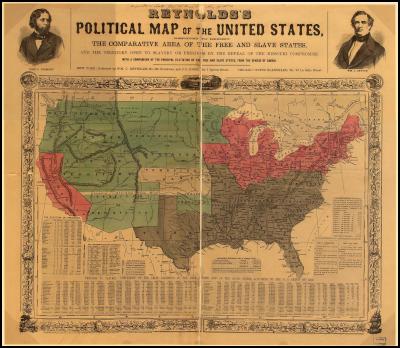Stateside with Rosalea: Kansas
Kansas
On February 26, 1867, in Kansas, “the gopher bill was changed by the Senate into a grasshopper bill, giving a bounty for all scalps of grasshoppers furnished with the ears”. So says the Kansas State Historical Society’s website, so who am I to argue! More importantly, the KSHS entry for 30 March, 1855, says this: About one thousand Missourians, under Samuel Young and Claiborne F. Jackson, arrive in Lawrence to vote, and do vote. Mrs. Robinson says: “They were armed with guns, pistols, rifles, and bowie-knives. They brought two cannon loaded with musket balls."
The election was being held to form a territorial legislature following President Pierce’s signing of the Kansas-Nebraska Act the previous year. The K-NA overturned the earlier Missouri Compromise, which would have outlawed slavery in the two territories if the K-NA hadn’t said the decision on whether to allow slaveholding should be left to those living there. The tale of that legislation’s passage in the House and Senate reads like something you’d read today about the passage of healthcare reform—only on steroids. Senator Stephen Douglas, of Illinois, latched onto a House bill meant to organize the Nebraska Territory and alienate the Indians’ land in order to push through a railroad, and turned it into a sop to Southern Democrats who wanted more slaveholding states.
Douglas bragged, “I passed the Kansas-Nebraska Act myself. I had the authority and the power of a dictator throughout the whole controversy in both houses. The speeches were nothing. It was the marshalling and directing of men, and guarding from attacks, and with a ceaseless vigilance preventing surprise.” As a consequence of that 1854 Act, both anti-slavery and pro-slavery supporters rushed to Kansas to stake land claims. It is in the anti-slavery sentiment of the events following the enactment of the K-NA that the Republican Party was born, and recruited another Illinois Senator, Abraham Lincoln, to run for President against Douglas in 1860.
A description of the brawl that took place in the House when Lincoln’s predecessor, President Buchanan, asked it to admit Kansas under an 1857 constitution that had given the territory’s voters a choice between being admitted as a slave state or as a state that would no longer admit slaves, is a classic. It was published in Frank Leslie’s Illustrated Newspaper, and is quoted in part in The House by Robert V. Remini. The punching and wrestling in the Chamber was such that:
Newspaper reporters in the “side
galleries,” thinking “they were in a vast oyster saloon
in a state of drunken demoralization, went to cracking
smutty jokes and pelting each other with spit
balls.”
“The madness finally turned to
comedy,” writes Remini, when a Wisconsin Representative
reached for the hair of a Representative from Mississippi
and the gentleman’s wig came off. The Gentleman from
Wisconsin, who was later to be known by the nickname of
“Bowie-Knife” cried out in surprise, “I’ve scalped
him!”, at which the House fell about laughing and ended
the melee. The outcome for Kansas was that both the House
and Senate voted instead to send the proposed constitution
back to the voters in Kansas, and this time they rejected
it. Kansas remained a territory with slavery until secession
and the departure of Southerners from Congress.
According to this Kansas State Historical Society webpage, “The last six southern senators left their seats on January 21, 1861, and later that same day the Senate passed the Kansas bill. A week later the House passed the bill as amended and sent it to the president for his signature.” At that time, Presidential inaugurations took place in March, so it was “President James Buchanan, a man despised by most free-state settlers in Kansas, who signed the bill making Kansas the 34th state on January 29, 1861.”
The domestic terrorism that had prevailed in the years between 1854 and 1861 earned the state the sobriquet Bleeding Kansas. A small taste of the violence in the territory can be gleaned from a letter to the editor of the Lawrence Republican in January, 1859. It was penned by John Brown, who was being hunted by authorities for leading a party to liberate some slaves in neighboring Missouri. Later that year, Brown attacked the federal arsenal at Harper’s Ferry, Virginia, was caught and hanged for treason.

But I don’t really want to dwell on Kansas’s bloody past. After all, it is the Sunflower State, as can be seen by the seal of the KS Department of Transportation. Just last week, Kansas Governor Mark Parkinson (D) signed into law a couple of bills that will improve passenger rail transportation within the state, including a service that will add a north-south link between Kansas City and Oklahoma City. From there the Heartland Flyer—an Oklahoma DOT/Amtrak service—travels down to Fort Worth, TX, from where the Amtrak Texas Eagle continues to San Antonio on the southern route across the United States.
I travelled eastward across Kansas on Amtrak’s LA-Chicago route, the Southwest Chief, back in May of 2004, mostly at night in a lightning storm. In March of 2007, I crossed the state again, but this time on a Greyhound bus going west. Again, it was mostly at night, and again there were lightning storms. When daylight did come, the sky was full of low clouds, some of which looked like they were about to spout tornadoes. My lasting impression of Kansas, therefore, is of vast expanses of emptiness prone to violent weather.
Alas, my travels there did not include a trip to gawk at the world’s largest ball of sisal twine or I might feel differently. Far be it from me to make fun of a badly written sentence since I write so many myself, but there is something so “grasshopper-scalp” about this sentence on the TravelKS website’s page about Cawker City’s claim to fame that I can’t resist bringing it to your attention: “At 17,320 lbs, 40 foot circumference, and over 7,938,709 [feet] of sisal twine, the Cawker City Community Club is the official owner/caretaker of the ball of twine.”
Man, those club members need to do some serious dieting! I guess they’re always wound up about something, too.
--PEACE—


 Bill Bennett: Another Pacific cable for NZ by 2026
Bill Bennett: Another Pacific cable for NZ by 2026 Suze Wilson - The Conversation: Luxon’s Leadership Test; What Would It Take To Win Back Unimpressed NZ Voters?
Suze Wilson - The Conversation: Luxon’s Leadership Test; What Would It Take To Win Back Unimpressed NZ Voters? Gordon Campbell: On The Coalition’s Awful, Not Good, Very Bad Poll Results
Gordon Campbell: On The Coalition’s Awful, Not Good, Very Bad Poll Results Ian Powell: Policy Vacuum Enables For-profit Corporate General Practice Ownership By Stealth
Ian Powell: Policy Vacuum Enables For-profit Corporate General Practice Ownership By Stealth Gordon Campbell: On Iran Killing Its Rappers, And Searching For The Invisible Dr. Reti
Gordon Campbell: On Iran Killing Its Rappers, And Searching For The Invisible Dr. Reti Peter Dunne: MPs Unusually Quiet On Pay Rise
Peter Dunne: MPs Unusually Quiet On Pay Rise